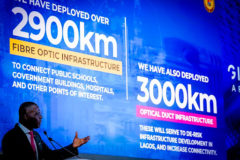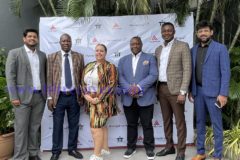The data centre giant growing a digital ecosystem on the Lagos Mainland.

In Africa’s ever-evolving digital ecosystem, Rack Centre holds a pride of place as the only carrier and cloud-neutral Tier III Constructed Facility Certified data centre in West Africa. The company, operating in Nigeria, focuses on providing best-in-class data centre colocation services and unlimited internet exchange interconnection and peering between carriers and customers.
[ad]
Nigeria is one of Africa’s key entry points for global telecommunications, content and cloud players, with about 85 million Internet subscribers, more than any country in the region or Europe. The interconnection metrics in the country are pointers to the significant growth of interconnectivity in the country. As of 2023, 250 licensed ISPs have been registered, about 60% are not operational or outside of Lagos, while about 10% are owned by enterprise businesses utilising the licenses for internal delivery. Interestingly, 65 networks are fully operational from Rack Centre, with 30 providing dark fibre or wave capacity.
[ad]
Despite the data centre market being very capital-intensive and highly competitive, Rack Centre has been able to carve a culture of operational excellence through solution-driven strategies that address its location on the Mainland and effective management of fibre cuts challenges. This strategy resulted in the company’s zero downtime in ten years, a rare feat in the Nigerian business environment of epileptic power supply, dearth of workforce and poor infrastructure.
Pushing the envelope
Currently, Rack Centre is expanding its data centre campus by constructing a new build, the LGS 2 data centre, with an IT power of 12MW. This is a quantum leap from the first facility, the LGS 1, which boasts a 1.5MW IT load and is home to over 65 telecommunication carriers, Internet Service Providers (ISPs), global Tier 1 networks, and pan-African international carriers, including direct interconnections to all five undersea cables serving the South Atlantic Coast of Africa including Equiano and in the foreseeable future 2Africa and every country on the Atlantic coast of Africa. On completion, the LGS 2 and its mammoth capacity will significantly contribute to the thriving Nigerian digital landscape broadening the company’s capacity and power to give more carrier-neutral access to the richest variety of network service providers and all cable landing stations in Lagos State.
Unlocking connectivity from the mainland
The solution has been at the heart of Rack Centre’s strategy, from Ikeja, on the Lagos Mainland, to its operational strategy. In terms of location, a data centre can be built anywhere, as long as power and connectivity issues are appropriately handled. However, the site is key because it will impact the service quality it can provide its customers. Choosing a good location translates to optimised infrastructure and application environment that helps for a wider reach, while a poor site can result in unstable connections and efficiency problems.
In the case of Rack Centre, the location of its LGS 1 and LGS 2 data centre campuses are favourable and strategic, sitting 30 meters above sea level, a vantage position against any form of flooding. It enables perfect redundancy for enterprise businesses with disaster recovery sites on the Island, giving it access to the largest population for FTTH service providers and access to the Southwestern part of Nigeria by Enterprise and Service providers. Added to this is proximity to the four compass points of Lagos with easy access to the airport, train and bus stations, and fire service stations. These are some of the key factors prospects customers/clients are looking for in a data centre provider beyond the physical security as they will guarantee disaster recovery, service levels, scalability, and reliability to ongoing support.
Data centres have supported businesses across various industries, helping them cope with digital transformation by offering infrastructure flexibility, better recovery options, and improved collaborative systems, among others at a lower cost.
[ad]
Re-routing as a solution to fibre cuts complaints
The presence of terrestrial and undersea fibre optic cables crisscrossing the four corners of the globe has made the internet possible, thereby aiding the interconnectivity between businesses, people and continents. Fibre optic cables provide much higher bandwidth speeds across very long distances. There are about 1.5 million kilometres of undersea cables in the world’s oceans. When the undersea cables reach the shore, they connect to cable landing stations, which serve as access points for terrestrial cable networks to connect with undersea cables.
One of the major causes of terrestrial fibre optic cuts is natural disasters due to wear and tear, which could cause breakages and lead to poor connection. In the case of distances, like it is with terrestrial/metro fibre distance from the cable landing stations in Lagos Island to Rack Centre on the Lagos Mainland, there could be mishaps. To mitigate such effects and maintain ideal connectivity for the benefit of its esteemed clients, Rack Centre has been strategic by plotting diverse fibre routes that promote a redundancy outlook to ensure operations continue even if a component fails. To avail of such situations, Rack Centre operates along five major diverse route entries, which allows for a reroute of service should a mishap occur along a specific route. These multiple redundant fibre connections have helped ensure infrastructure flexibility, better recovery options, and improved collaborative systems. The five major diverse routes are: through Eko Bridge, 3rd Mainland Bridge, Carter Bridge, Ikorodu into Epe to Lagos and Sagamu, Ijebu-Ode, Epe to Lagos. The effectiveness of these diverse routes is the flexibility to switch to other routes in case of a mishap.
[ad]
More solutions to better connectivity
Rack Centre is going beyond re-routing fibre optic cables in the case of mishaps to embracing new and direct metro fibre deployment between cable landing stations such as Brainshare networks, I2M Cable by Cedarview and FLV. As a carrier-neutral data centre, Rack Centre also enables subsea cable partners to terminate at its facility, allowing for more connectivity as it enables the partners to be closer to their customers and business partners. The Subsea cable partners terminating at Rack Centre consist of the following leading connectivity solutions providers: WIOCC: – 2Africa Submarine, NATCOM:– SAT-3 Submarine Cable, PCCW: – Sat-3 Submarine Cable, Liquid Intelligence:- SAT-3 Submarine Cable, Liquid Intelligence: – WACS Submarine Cable, PCCW:- WACS Submarine Cable, Dolphine Telecoms:–ACE Submarine Cable, MTN:-ACE Submarine Cable, Orange:-ACE Submarine Cable, Glo:-Glo-1 Submarine Cable, MainOne:– MainOne cable Submarine Cable, and MainOne:- Nigeria Cameroon Submarine Cable System (NCSCS) Submarine Cable.
The presence of these subsea cable partners at Rack Centre is a testament to the operational excellence and projects the vast opportunities available in the thriving Nigerian digital marketplace. It also highlights the necessity of expansion in the construction of the LGS 2 campus data centre, which increases the Rack centre data campus capacity to 13.5MW.
As the first IFC Edge Green building-certified data centre campus in the EMEA region, the company is not letting down its guard in ensuring that Nigeria’s economy becomes smart and that the digital ecosystem in Africa is at its optimal best. With the ongoing construction of the LGS 2 campus data centre, Africa would have enough capacity for enterprise businesses, small and corporate businesses, Telco & Carriers, financial institutions, international cloud and content providers and hyperscalers to enjoy latency reduction from Rack Centre.



















